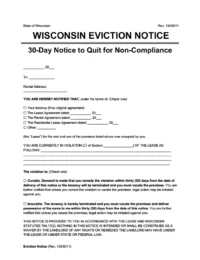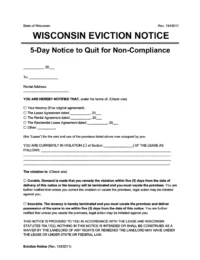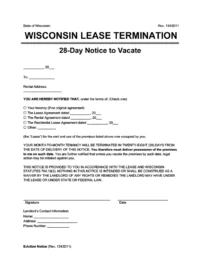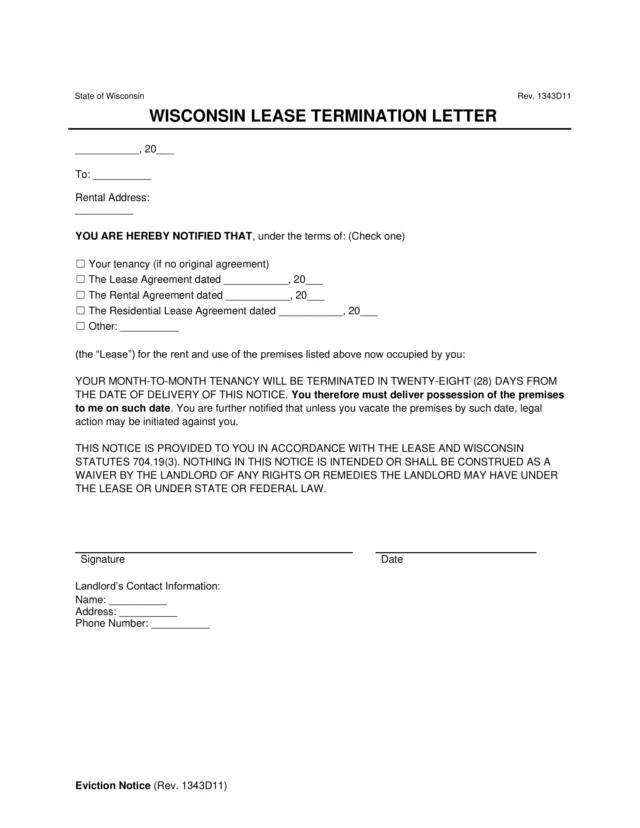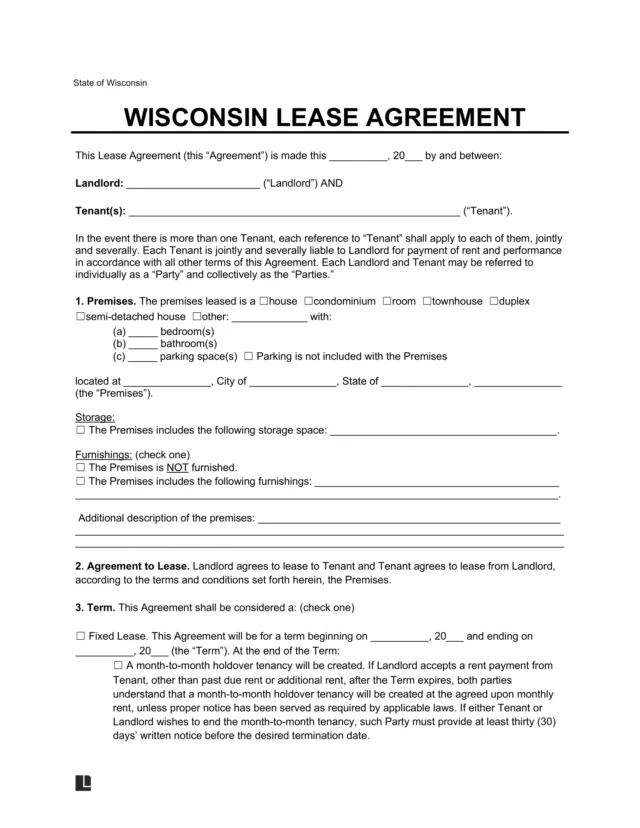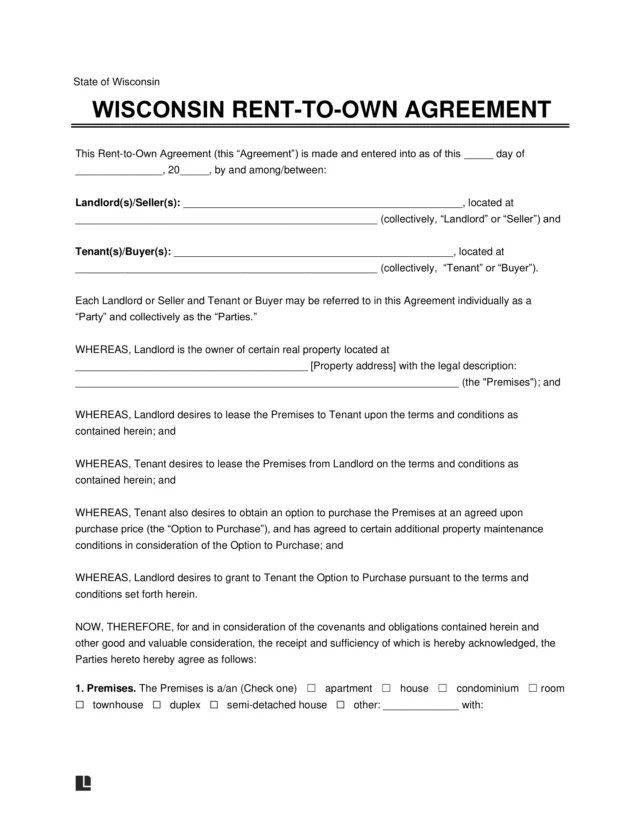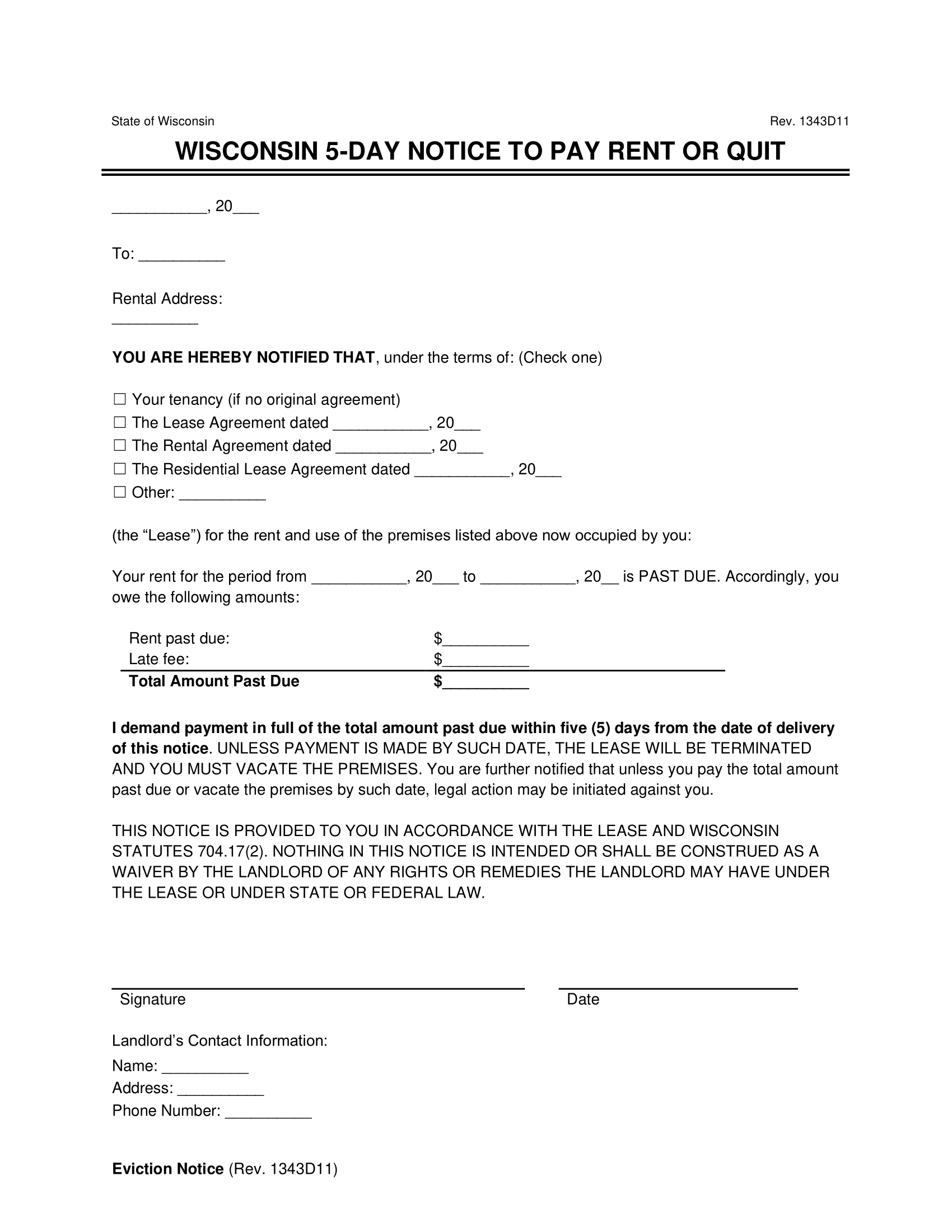Understanding Eviction Notices in Wisconsin
Wisconsin law requires landlords to serve tenants with a written notice before an eviction can proceed in court. The notice issued depends on the cause, whether it be unpaid rent, lease issues, or ending a tenancy.
Our document editor guides you through the process of making a Wisconsin eviction notice. Download it in PDF or Word format.
Types of Eviction Notices in Wisconsin
Wisconsin differentiates between eviction notices based on how long the lease is and why the landlord is ending it.
5-Day Notice to Pay Rent or Quit
This notice explains that a tenant’s rent is overdue and that they must pay it within five days. If the tenant doesn’t pay the overdue amount within five days, they must move out of the property. Failure to comply will result in an eviction proceeding.
Per WI Statutes § 704.17(2), a landlord should only issue this notice to tenants who have lived at the property for less than one year.
5-Day Notice to Pay Rent or Quit
Evict a tenant on a lease for a year or less if the tenant hasn’t paid rent on time.
30-Day Notice to Pay Rent or Quit
Send this form to ask a tenant to pay overdue rent within 30 days or move out. Under WI Statutes 704.17(3), this notice is only for tenants who’ve lived on the property for over a year.
If the tenant ignores the notice by not responding or not paying the full rent amount, a landlord can take them to court and file for eviction. If the court rules in the landlord’s favor, the tenant must move out according to the court’s orders.
30-Day Notice to Pay Rent or Quit
Evict a tenant on a lease for more than a year if the tenant hasn’t paid rent on time.
5-Day Notice to Quit for Non-Compliance
If a tenant has lived at your property for less than one year and violated the lease, send them a 5-day notice. This notice, per WI Statutes § 704.17(2)(b), gives them five days to fix the breach, take reasonable steps to make things right, or move out.
5-Day Notice to Quit for Non-Compliance
Give tenants five days’ notice before the eviction process can proceed in court.
30-Day Notice to Quit for Non-Compliance
This notice explains a first-time lease violation by a tenant who has lived on a property for more than one year. If the tenant doesn’t correct the breach within 30 days, they must vacate the property under WI Statutes § 704.17(3).
However, if the tenant offers to pay for the inflicted damages or reasonably attempts to comply with the notice, the landlord may not force them to move out.
30-Day Notice to Quit for Non-Compliance
Give tenants 30 days’ notice before the eviction process can proceed in court. In that time, tenants may be able to fix (or “cure”) the problem.
28-Day Notice Lease Termination
Issue this form when you intend to end a month-to-month lease. Per WI Statutes § 704.19(3), you should give at least 28 days’ notice. Ensure that you deliver this notice in a timely manner and in a way that guarantees a receipt.
28-Day Notice Lease Termination
Let a tenant know that you’re ending a month-to-month lease.
How to Evict a Tenant in Wisconsin
In Wisconsin, eviction lawsuits are governed by Chapter 799 § 799.40 through 799.45 of the Wisconsin Statutes.
Step 1 – Provide Written Notice
A landlord must notify the tenant of the reason(s) for eviction: non-payment of rent, non-compliance, or termination of a month-to-month tenancy. The notice must be properly served with evidence of the service, such as an affidavit or certified mail receipt.
Step 2 – Wait for the Tenant’s Response
The tenant has five days to fix the problem, either by payment or curing non-compliance; if they do so, the landlord may not proceed with the eviction filing. For a second violation within the same year, the tenant must be given 14 days’ notice to vacate the premises, but the landlord doesn’t need to allow the tenant to pay.
If the tenant has been living on the property for more than one year, they must have 30 days to pay rent or fix a compliance issue.
Step 3 – File for Eviction
If the tenant fails to respond by the required time and remains on the property, the landlord files a Forcible Entry and Detainer (eviction) action in the local circuit court where the property is located.
Landlords must file a Summons and Complaint and state why they want the tenant to move out in the eviction complaint. Landlords must also complete a Non-Military Service Affidavit and Affidavit of Service of Notice. The court will set a date for the hearing and return on that date to plead your case to the judge.
Step 4 – Serve the Tenant
The court will keep the original summons and complaint, and you must deliver the copies to a process server to serve your tenant. The tenant must be served five (5) days before the court date and may defend themselves by filing an Answer and Counterclaim form.
Step 5 – Attend the Court Hearing
Attend the court hearing, during which you and the tenant will present your evidence for the case. The court will weigh both sides and make a fair, informed decision.
Step 6 – Receive the Writ of Restitution
If the court finds for the landlord, it will grant a Writ of Restitution. The landlord must provide this form to the sheriff, who will complete the eviction. The sheriff will have ten (10) days to evict the tenant after receiving the Writ of Restitution.
Related Wisconsin Court Forms
- Summons and Complaint (SC-500I): The landlord completes this form and files it with the local circuit court.
- Declaration of Non-Military Service (GF-175): The landlord files this form along with the eviction complaint to state whether a tenant is on active military duty.
- Affidavit of Service (SC-5100V): This form affirms the proper service of the Summons and Complaint on a tenant.
- Answer and Counterclaim (SC-5200V): Tenants may respond to the allegations in the eviction complaint by filing this document with the court. A copy must also be delivered to the landlord.
- Writ of Restitution (SC-512): This document is issued by the court after an eviction lawsuit has been settled in favor of the landlord, and it allows the sheriff to remove the tenant from the premises.


